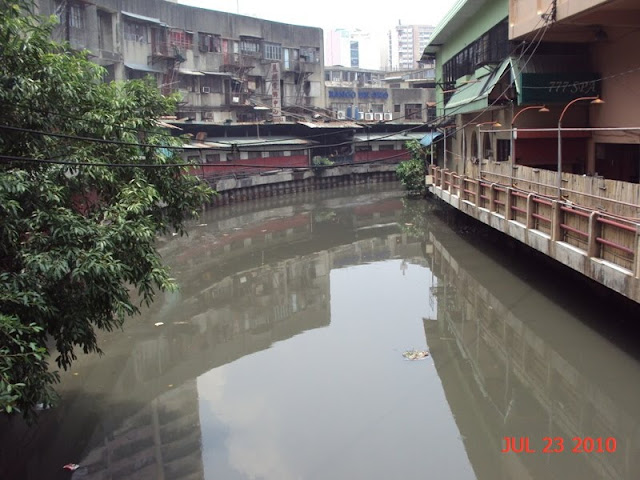( You can enlarge the images by clicking it with your PC mouse )
Photo Essay of my walking tour of Ongpin Street from the vicinity of Sta Cruz Church till the Plaza of San Lorenzo Ruiz in Binondo.




















Polluted estero in Ongpin street.

Polluted Estero in Ongpin Street.





Binondo is an enclave in Manila primarily populated by Chinese immigrants living in the Philippines. Historically, the place called Parían near Intramuros was where the unconverted Chinese immigrants (called Sangley by the Spaniards) lived while Binondo was the place where the converted sangleys and their descendants, the mestizos de sangley or Chinese mestizos resided. The Parian was sited by the Spaniards within the range of Intramuros cannons, to prevent any uprising coming from the Chinese.
Binondo is located across the Pasig River from Intramuros and the home of Chinatown in Manila. The district is the center of commerce and trade for all types of businesses run by Chinese merchants. It is said that this district was already a hub of Chinese commerce even before the Spaniards came in 1521.
Prior to Makati, Binondo was the main center for business and finance in Manila for the Chinese, Chinese mestizos and Spanish Filipinos. Before World War II there was a bustling banking and financial community which included insurance companies, commercial banks and other financial institutions from Britain and the United States. The banks were located mostly in Escolta which used to be called the "Wall Street of the Philippines". After the war most of these businesses began to relocate to the newly developing area of Makati, which is mostly owned by the Ayala family. Binondo is also famous for its imitation of a small Chinese town which is locally called "China Town". During the financial crisis of the early 80s, Binondo earned the nickname "Binondo Central Bank" as Chinese businessmen in the district engaged in massive black marketing of US dollars, often dictating the actual Peso-Dollar exchange rate. The term has survived to this day.





Founded in 1594, Binondo was created by Spanish Governor Luis Pérez Dasmariñas as a permanent settlement for converted Chinese immigrants (called sangleys) across the river from the walled city of Intramuros where the Spaniards resided. It was originally intended to replace the Parian near Intramuros where the Chinese were confined. The land grant was given to a group of Chinese merchants and artisans in perpetuity, tax-free and with limited self-governing privileges.
The Spanish Dominican fathers made Binondo their parish and succeeded in converting a great many of the Chinese residents to Catholicism. Binondo soon became the place where Chinese immigrants converted to Catholicism, intermarried with indigenous Filipino women and procreated to produce a nascent Chinese mestizo community. Over the years, the Chinese mestizo population of Binondo grew rapidly. This was caused by two factors: the lack of Chinese immigrant females and the policies of the Spanish authorities in expelling and massacring pure-blooded Chinese immigrants who refused to convert. Those who converted were allowed to intermarry and to reside in Binondo. Luis Pérez Dasmariñas played a prominent role in the massacre of 24,000 Chinese after a Chinese revolt in 1603. The official reason was the perceived threat posed by the sangleys to the newfound colony. However, it was most likely because Luis Pérez Dasmariñas wanted to avenge the death of his father Gómez Pérez Dasmariñas at the hands of sangleys in 1593.
Binondo is the historic birthplace of the mestizo de sangley or Chinese mestizo. It was also the birthplace of St. Lorenzo Ruiz, a mestizo de sangley who would later become the First Filipino Saint. Mother Ignacia del Espiritu Santo, who is also a mestiza de sangley, was the founder of the Congregation of the Religious of the Virgin Mary. Plaza Lorenzo Ruiz and the Binondo Church (formal name: Minor Basilica of St. Lorenzo Ruiz) are named after him. And the Chapel of Our Lady of China is also in the Binondo Church.
You can read more at the below link :
http://en.wikipedia.org/wiki/Luis_P%C3%A9rez_Dasmari%C3%B1as



Plaza San Lorenzo Ruiz




Plaza San Lorenzo Ruiz

ATTRIBUTION LICENSE :
You may use the pictures in this blog under an Attribution License. You are free to use, share and modify the pictures found in this blog. Should you publish or otherwise reproduce for distribution the pictures found here in digital or printed form you must place a link to this blog or indicate the URL of this blog in your publication. Thanking you.
Related story / web link :
Binondo
http://en.wikipedia.org/wiki/Binondo
Binondo Church
http://en.wikipilipinas.org/index.php?title=Binondo_Church
Attempted conquest of Luzon by the Chinese Pirate – Limahong
http://jibraelangel2blog.blogspot.com/2010/07/attempted-conquest-of-luzon-by-chinese_24.html
The Chinese in the Philippines during the Spanish era
http://jibraelangel2blog.blogspot.com/2010/07/chinese-in-philippines-during-spanish.html
Youtube Videos :

No comments:
Post a Comment